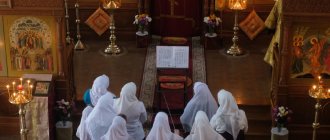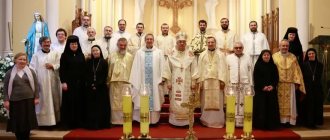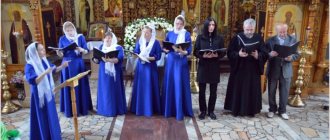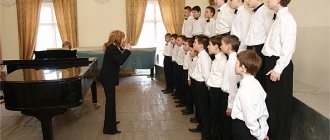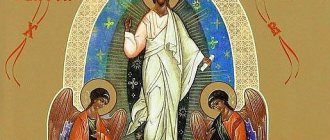Pavel Kataev , a theorist of znamenny singing, a member of the LIK choir group , dated March 20, 2021 at the Nizhny Novgorod Sunday School named after. Venerable Sergius of Radonezh. The author continues his research on ancient Russian music. This time we will talk about the banner, after which Old Believer singing is often called kryukov, i.e. about " Hook ". The author’s presentation of the spiritual understanding of this sign is interesting. The study will be of interest to both experts and all lovers of Old Russian Znamenny singing.
Hook. Theology in the Banner
Taking advantage of God's patience and your condescension, I will share the knowledge that I have acquired. And it would be nice if this knowledge would benefit someone. To help those wishing to study Znamenny singing, a course of lectures on the spiritual meaning of Znamenny . A total of 12 lectures are planned on a deep understanding of individual banners, and one on the principle of osmoharmony, scales, faces and fits. Our first conversation took place several years ago. Then we were talking about the first banner of the hook alphabet - the Paraclete. Today we will talk about the banner, by the name of which our hook singing is often called, i.e. about " Hook ". Once upon a time, the hook in singing manuscripts was depicted something like this:
Then like this:
And around the 17th century, it began to be drawn like this:
In general, all the banners have undergone some changes in design. At first they were barely noticeable.
Then they stretched out horizontally above the words of the text, occupying the space between the lines. And then, they “rose up” and “straightened their shoulders.” And now the banner line takes up more space in the book than the text line.
Banners play a supporting role in worship. They were born when the words were chanted, but now they take up more space on a piece of paper than the words themselves. The hooks grew as their assistance in remembering the melody increased. And they finally “grew and became stronger” when people endowed each of them with spiritual meaning. Nowadays, a lot of things are done without much meaning: “just like that.” In fact, nothing happens “just like that.” Any action, any deed goes either to the detriment of the soul or to the benefit.
A believer’s life is imbued with a spiritual understanding of events. At the same time, a person’s desire to see a spiritual, sacred meaning in everything should not be brought to the point of absurdity, i.e. to animate soulless objects or to deify something. This desire can be compared to a craving for beauty. There are many examples of this from folk life, when something is done both practical and beautiful. Let's take an example from church life. The history of the development of the iconostasis shows us how a magnificent wall with icons in several rows grew from a small partition.
So are the banners. In addition to their purpose of suggesting a melody, they have additional beauty. It lies in the spiritual, moral characteristics of each banner. Probably, these additional characteristics of the banners were born for educational purposes when training young singers. Additions to the Slavic alphabet have a similar principle:
Az - Az is the light of the world
Buki - God is before all ages
Lead - I know all the secrets in a person and the thought
Verb - I tell people My law
etc.
Likewise, hooks have a theological definition that begins with the same letter as the name of the banner:
Paraclete - the message of the Holy Spirit from the Father to the apostles on the day of Pentecost
Hook - a strong mind to guard against evil
Snake - escape from earthly glory and the vanity of this world
These characteristics always have a stimulating orientation and speak of some action that is beneficial for the soul. These additional meanings of hooks are like excerpts from the code of laws of monastic life: watch, lament, be humble, practice prayer - and you will be saved. That is, these are recommendations to a person for his Christian behavior. Since a person goes to God all his life, the actions here are displayed as constant: everlasting, constant. You can't say:
Yesterday I already brought my grandmother across the road, now I can no longer help anyone for a week.
Or:
Polunoshnitsa prayed for the year ahead.
Among all the hooks, there is one such hook that does not, like all the others, symbolize man’s desire for God. On the contrary, it speaks of the descent of God to man. This is the Paraclete - the message of the Holy Spirit from the Father to the apostles on the day of Pentecost. This is the first hook in the Znamenny alphabet and in many chants. He talks about the movement of God towards man. And after this, all other banners show the movement of man towards God. It is like baptism, during which the grace of the Holy Spirit descends on the person being baptized, and subsequent life, during which a person strives for God. Probably, the appearance of spiritual meaning in the banners was required in connection with the growing influence of secular music on the minds of people, as if in counterbalance to this influence.
The spiritual basis of Znamenny chant
Any music is built according to known laws. It has a mysterious and subtle effect on the human soul. We are used to music being sad and cheerful, energetic and slow. The Znamenny chant is calm, like the surface of a lowland river, moving smoothly in time, moving through sounds like water moving through stones.
Why doesn’t this flow of sounds clearly affect my emotional state, doesn’t wake me up, doesn’t make me happy, but puts me in a sedate, seemingly insensitive mood? What kind of philosophy is hidden inside the znamenny melodic series, what kind of way of thinking?
In Znamenny chant, a different, archaic type of thinking is noticeable, which is difficult for modern people to understand. Before classical modern music, many peoples sang and thought exactly this way. Ancient Tatar, Bulgarian, and Celtic songs resemble a drawn-out Znamenny chant. Perhaps Znamenny chant and classical music are two different attitudes towards sounds in general? Remember, as in the Bible: the youths in the oven did not listen to the “Musician organ,” but sang Divine hymns in the fire. “ Musikia ” is music in Church Slavonic. Orthodox Christians have always been against a frivolous attitude towards the reproduction of sounds. So, in Rus' they did not respect buffoons and balalaika players. (Although our three-stringed “friend” is the only musical instrument that has preserved the ancient three-step scale). Christians were not allowed to sing “shameful songs,” and to this day Old Believers sing only spiritual poems. In the wonderful book of Boris Kutuzov, I found answers to many philosophical questions.
Znamenny chant is truly folk art, or, to put it differently, cathedral creativity. This is undoubtedly the main and main trunk, from which shoots and branches of paraliturgical creativity then sprang. (B.P. Kutuzov. “ Russian Znamenny singing ”).
Pavel Florensky wrote that the fine arts “historically are links that have fallen out of their nests or jumped out of a more serious and more creative art - the art of God-making, Feurgy.” And Feurgia itself in ancient times “was the mother’s womb of all sciences and all arts... The autonomous existence of extra-Theurgic activities was a blasphemous crime and was viewed as such. And in even more ancient times, the very thought of the possibility of their independence did not and could not arise: in a strong and healthy consciousness, even a glimpse of madness is excluded.”
The autonomous existence of these historically “jumped links” of more serious work had its beginning in Muscovite Russia in the middle of the 17th century, when by decree of Tsar Alexei Mikhailovich , in imitation of the West, the first theater in Russia was created, and at court and in society, through the efforts of the same sovereign, it received the development of “free pietism”, implanted by the tsar’s favorite, the Uniate Simeon of Polotsk . After the Nikon-Alekseev “reform” and then the split, the old Russian church art was labeled as “Old Believers.” Russian icon with its writing traditions dating back to St. Andrei Rublev and Dionysius , as well as Russian Znamenny singing, were declared obsolete, expelled from churches and replaced by Western examples of painting and partes singing in the Catholic-Protestant spirit.
“Reform” provoked and programmed for the entire future the persecution of everything Russian, which was defamed, declared obsolete, insignificant, requiring replacement with modern foreign models. Already in the next century, the noble class, brought up in a cosmopolitan spirit by foreign tutors, looked at Russian singing (at that time that was what the znamenny chant was called) as music for the mob, serfs, while the need of the “noble” visitors to churches became church singing in the Western style. As society became de-churched, culture gradually became “autonomous in relation to the human person,” and then, finally, “rushed along its own path, conquering man. (B.P. Kutuzov “ Russian Znamenny singing ”).
From darkness to light
To consider the Hook banner, it is necessary to recall a little about the structure of our church scale, the so-called hill. Sometimes we also call it the gamma ladder.
We may talk about it in more detail at the last lecture. Now I would like to remind you that the scale symbolizes the spiritual growth of a person from darkness to light, ascent to the heavenly world. And at the same time it consists of four agreements of three levels in each: simple, dark, light and three-light. Some banners have signs of belonging to some kind of agreement. Therefore, all banners can be divided into two groups:
- Banners with signs of agreement;
- Banners that do NOT have signs of agreement.
The hook has signs of agreement and therefore comes in four types: simple , dark , light and three-light .
Three directions
Initially, Russian singers only learned to sing according to Byzantine, mainly Bulgarian, models. Little information has been preserved about the first creators of Old Russian chant. It is only known that these were monks who learned to sing “from mouth to mouth.” Gradually, many singing schools arose in Rus': Kiev, Novgorod, Rostov, and already the chronicles of the 11th century tell about “proud” singers.
Over time, three directions emerged:
- "pro-Byzantine";
- "pro-Russian";
- "compromise".
The first direction included the Kiev nobility and the highest Byzantine clergy, who arrived on an Orthodox mission to Rus'. His supporters did not make any amendments or additions to the Byzantine style of singing. In fact, it was a “tracing copy” of Greek chants.
The opposite point of view was held by supporters of Russian antiquity: they proposed using only texts that were “superimposed” on national melodies.
Representatives of the third movement - educated people who belonged to different classes - merchants, clergy, military men who had contacts with Byzantium, adopted texts, notation, octagonism, and compositional techniques from Greek singing art. At the same time, the mode-intonation fund was borrowed from Russian music.
Thus, by comprehending the best examples of the singing art of Byzantium and “grafting” it onto Russian soil, the znamenny pillar chant - the basis of the foundations of Russian liturgical singing.
The hook is simple - a sound mind that protects from sin
This strength of mind helps us make singing reasonable and intelligible. Because the hook is placed above the stressed syllable in the word . The hook reminds us that when performing a stichera, it is necessary to fill it with the meaning contained in the sung words of this stichera. By this we will save ourselves from the sin of idle, meaningless fulfillment of this prayer.
To keep is to observe, look after, store, protect.
To avoid evil (sin), it is necessary to take active actions - watch out. Of course, i.e. without doing anything, without effort, evil cannot be avoided. You must firmly understand with your mind what is good and what is bad; and protect yourself from bad things.
Gloomy hook - strong chastity skill
The word chastity combines two concepts: integrity and wisdom. Whole means without damage, perfect. The opposite of this is something not whole, half-hearted, damaged. For example, crazy does not mean that the person is smart, but not smart enough - only half, but means that the person has a damaged mind. Wisdom is to maintain your integrity .
Chastity is prudence, purity of thoughts and body; purity. Habit is a long-term custom, habit.
The gloomy hook symbolizes chastity, which is so “ingrained” into the consciousness that it has become a habit. Keeping oneself spiritually and physically clean has become commonplace.
“You need to sing Znamenny in such a way that people want to hear it”
Andrey Nikolaevich Kotov is the leader of the ensemble of ancient Russian sacred music “Sirin”, singer, composer. Continuing the conversation about traditional culture, we decided to ask the performer in detail about authentic singing, its meaning in our lives and other subtleties of ancient Russian sacred music.
Andrey Nikolaevich Kotov
– Andrey Nikolaevich, tell us about your creative path. When did you get closer to Russian traditional culture? How did she capture you?
– I’ve been involved in traditional music for a long time. He worked in the ensemble of D. Pokrovsky, which refers to Russian traditional culture, Cossack culture, Russian folk theater, spiritual poetry, and Old Believers.
I've been singing all my life. And my mother sang. He knew opera and Soviet pop music of the 1960s, sang in a choir, a folk instrument ensemble, organized a vocal-instrumental ensemble as a teenager, sang bard songs and went on hikes. I was interested in any good music.
Studied at the Gnessin Institute. Entered the people's department. But the concept of folklore did not exist for me. And literally two weeks after I started studying, I had a decoding lesson: the teacher gave me a recording of some three-voice song to decipher. And when I heard this... I was so amazed! An incredibly beautiful combination of voices. And I realized that there is such authentic music that is strikingly different from everything I had heard before. It was a shock for me.
Andrey Kotov among the members of Dmitry Pokrovsky's ensemble
The head of our department introduced me to Dmitry Pokrovsky in 1978. And after the army I returned to Pokrovsky’s ensemble. This is a legendary team. The first people who brought authentic folklore onto the stage instead of “cranberries”. There was a demand for them, they updated folklore and raised it to the level of serious music. Writers, poets, musicians came to our concert... We were friends with V. Rasputin, A. Schnittke, R. Shchedrin. For them it was a real outlet. We literally conquered the entire Soviet Union. Thanks to our performances, the folklore theme was raised in many cities, and ensembles appeared.
I worked for Pokrovsky for ten years. He really wanted his students to each pursue their own direction. Pokrovsky suggested that I turn to spiritual poetry and ancient Russian music. But everything was interesting to me, and I agreed. And Pokrovsky brought me together with people who went on expeditions. I knew D.S. Likhachev listened to his stories with his mouth open. Deciphered banners[1] in ancient manuscripts. This is a very difficult job. After all, if you really want to, you can learn to sing hooks in a month. And decoding is aerobatics.
The specialists gave me directions. In Riga I met the Pomeranian mentor I.N. Zavoloko. I copied his entire archive! On the Don he recorded songs of Cossack Old Believers. I also listened to the Nekrasov Cossacks. They sang from memory, not hooks, and retained the pre-European melodic language (this is one of the versions). They sang in dialect[2].
– Ancient singing – naon[3]. How is this tradition perceived today?
– As for this singing... Today's Old Believers have not fully understood it, and even less so have those who ruled it in our days. As a professional musician, I understand perfectly well that all naonic endings of words are vowels of these very endings. It’s just that when you end a word with a consonant, and the chant is still going on, for example, you sing the word “shame”, and you have two more sounds ahead, the bannermen of the old days put an “o”, which was sung. But this “o” did not belong to the word, it belonged to the sound. And if you perceive these connections as connections, and not as belonging to a word, everything will fall into place for you. The feeling is that the people who edited the ancient books did not perceive Znamenny singing[4] as the existence of a living word, for them it was music. They were brought up in European thinking, separate from the musical word. Therefore, for them the existence of words and sounds was separate. And the people who already sang in a long, large znamenny chant, when the chant is long and the word is short, put down these vowels in order to know how to sing the chant. For me, as a singer, this was obvious. If you pronounce it not as a word, but as a sound, your word will not be distorted.
(MP3 file. Duration 4:58 min. Size 12 Mb)
“God is with us” (fragment). Hymn of the Znamenny chant, tone 8. Ensemble "Sirin"
– What do you feel when you encounter Znamenny singing?
When you sing in unison, you become one voice with the entire choir. You hear not yourself, but the prayer and are present in it
– In the Pokrovsky ensemble we sang stichera by Fyodor Krestyanin, transcribed by M.V. Brazhnikova. In the 1970s, the book “Masterpieces of Old Russian Singing Art” was published. There were these stichera by Fyodor the Peasant, 16th century. I was amazed by the power of the chant, the very state of unison singing. Today, not everyone can achieve this, by the way. Unison is when you don’t hear yourself and turn into one voice with the entire choir. “With one mouth” - that’s what it’s called. Your voice doesn't stick out. Neither yours nor the boss. You hear not yourself, but the prayer and are present in it. This is difficult for a modern person to achieve, because we were brought up in a certain individualism, we have our own “I”, our own beautiful voice... But among people of tradition, collective singing was and is a joint experience. Therefore, none of them will ever oppose themselves or stick out, because for them the most valuable thing is to be together. In unison singing, the most valuable thing is “with one mouth.” Modes, rhythms, tonality may change, but it doesn’t matter at all. I never went on an expedition to collect material; the task was to understand why Znamenny singing is sung this way and not otherwise.
– How does the Russian traditional song “build and live” help?
– We use the word “traditional” all the time. What is tradition? This is a certain set of positive experiences that are passed on because they are good. Grandma's traditional recipes, clothes and more. All this is passed on to us from our ancestors for a reason, but because, despite the perishability of everything and everyone in this world, something valuable reaches the next generations. Yes, so that it would be valuable for children, with life.
Traditional singing is part of traditional life. If there is no society in tradition, there is no traditional song, it turns into archaic art or simply disappears. I am a professional musician, and for me it’s all music, but when on the expedition I had to encounter people of tradition, I was amazed that they never created anything or declared anything like: “Now we will sing you a great Russian song!” They said: “We will sing our song.” And people lived inside this song! They talk to each other while they sing. A true traditional culture implies complete freedom within itself within the framework of the language that these people speak.
Yes, you can't sing any other tunes. But when I sing along the banners, I feel like a creature of God
And if we talk about the Znamenny chant... Yes, you cannot sing any other melodies. But when I sing according to the banners, I don’t have the problem of self-identification. I am present in the word of prayer, I feel like a creature of God. The value and meaning of the word begin to be understood differently. After all, when we sing from the stage, we share our experience. And when I sing something in Znamenny chant or read the Psalter according to the rules, the text begins to come to life in front of me and I hear it. Why are intonations prohibited in church reading? So that I don’t fill meaning with my passions. And if I don’t fill it with this, I begin to hear the word, and it can reveal something to me that I don’t know. And this possibility of discovery is inherent in the system of church reading, znamenny singing and in traditional culture in general. Freedom within language. Inner freedom. Not permissiveness, but freedom.
– Does a person have an internal rhythm? How does he influence folk music and him?
– There are folk peasant songs of the 19th century, and there is “Russian rock”. How is it different from English? Russian rock thinks in Russian. The traditional melody of any nation is created by language. Because the words that a person pronounces contain intonation. Singing differs from speech only in that the intonation is rhythmic. A modern person can listen to anything. When he listens, one hemisphere rules, and when he sings, the other. To join any culture, you need to perform it, make it your own and participate in it. Then you begin to include yourself in it. In the meantime, you just listen - you get the drug in small doses. When you perform or even come to a live concert, the perception is completely different.
And the internal rhythm of a person... Well, put your hand on the pulse - this is your internal rhythm. There is a concept of internal harmony, when the rhythm of breathing, movement, pulse, emotions are in harmony. I once read that running is harmful. A dog or horse running is normal. Man - no. A person runs in two cases: either he is chasing someone, or he is running away from someone. In these cases, his physical and emotional state coincide and do not destroy the person. But if you are running and your emotional state is at zero, at that moment there is a gigantic load on the body. Singing and dancing, for example, harmonize internal rhythms. Having experience in singing and dancing, a person controls his rhythms very well.
– What is your attitude to the fact that Znamenny singing, traditional for Russia, has almost everywhere been replaced by European partes[5]?
If we lived at the end of the 17th century, the conversation about partes would be relevant. And now partes is part of our culture
– The Znamenny system was 80% oral. What is our last book translated into banners? Daily life. Why? Yes, because it was clear to everyone. By the age of 7, the child’s entire intonation system was in the “ears.” This chant is written with this icon, and that’s it. This was the approach through real church life. And today we are trying to come by artificial means to what was natural then. Therefore, stupid problems of confrontation between adverb and naon singing in Znamenny chant arise. And if there is a desire to show that only ours is right, this is stupidity and pride.
If we lived at the end of the 17th century, the conversation about partes would be relevant. But the harmonious sound of partes has been embedded in the genetic code of the people over the past 300 years. It is natural, and this need is natural. All modern Cossack song was formed in the 19th century, and it was formed by Partes. The language was associated with church singing. And partes is part of our culture. This cannot be excluded. If we want to change something, we need to change our lives. And the Znamenny must be sung at the service so that people want to hear it.
(MP3 file. Duration 0:51 min. Size 2.1 Mb)
“Virgin Mother of God, rejoice” (chant of the Moscow Resurrection Monastery, 19th century). Ensemble "Sirin"
– Is it possible today to return to a traditional way of life?
– Nothing can be revived in its original form. If we want to have a high-type traditional culture, we need to go to the countryside. 100, 200, 300 years will pass, and a stable tradition will appear. We don't know what it will be like, but we can create the conditions. Everything else is reconstruction.
"When I was young." Andrey Kotov and the Sirin ensemble
Light hook - strong, constant vigil in prayer
The resulting logical chain is interesting: simple hook → dark → light. First you need to think about the fact that you need to guard yourself from evil, i.e. sin. To do this, you need to make chastity a habit. The habit of chastity is reinforced by vigil in prayer.
Hook - strength of mind in guarding against evil
Hook of the gloomy - strong chastity skill
The Hook of the Light—Strong, Always Vigilant in Prayer
Vigil - staying awake, spending time without sleep; care, care, diligence. To be vigilant is to vigilantly watch over someone or something, to keep, to take care, sometimes it means to live piously, righteously, abstinently, in the Orthodox faith. Vigilant - very attentive, relentlessly alert.
The phrase “vigil in prayer” can be understood in two ways. Firstly, stay awake and constantly remain in prayer (for example, Jesus). Secondly, be attentive to the prayer itself, and do not distract your mind from the meaning of the prayer being said.
The three-light hook is a strong struggle according to true faith
Truer faith ! This means that there is also untrue faith. Let us give an example of true faith. Nebuchadnezzar set up a golden image and ordered everyone to worship it as a sign of faith in his power and divinity. Resistance was punished by a giant flaming furnace. And three Jewish youths refused to bow to the idol, because they worshiped only the True God . This was precisely a struggle that was strong according to true faith. Let me draw your attention to the fact that according to the laws of speech, there is a difference between faith in the True God and faith in the God of Truth. There is no need to be confused. Also, as an example of the True Faith, one can cite all the holy martyrs for the Christian faith, including those who suffered for the ancient piety.
Wrestling can be different. The Seven Ecumenical Councils are also a strong struggle for true faith. The works of John of Damascus are also struggles according to true faith. And in general, all the creations of the holy fathers, martyrdom and military feats for the Orthodox faith with this formulation - a strong struggle according to the true faith - are collected in this small icon, in this graphic element of the banner notation, which is called the Three-Bright Hook .
The hook banner is the banner of Faith, the banner of the Old Believers!
The banner must be held high so that everyone can see it, so the hook is three-light, i.e. sung in the high part of the sound range.
The word is reasonable
In the theological characteristics of the hook, no matter what consensus it belongs to, there is the word “ strong ”.
Hook - strength of mind in guarding against evil
Hook of the gloomy - strong chastity skill
The Hook of the Light—Strong, Always Vigilant in Prayer
The hook of the three-light one is a strong struggle according to true faith
This strength is expressed when singing the hook. Because, as we have already said, it is based on strength, i.e. at the place of semantic stress. Stresses in words are necessary to maintain the meaning. Stresses in words help convey to listening people the semantic load of words that is reflected in them. If the emphasis is not wisely observed, then the result is nonsense—nonsense. Unreason is very often compared in the canons with speechlessness. That is, the loss of the meaning of speech is the same as the loss of the gift of speech.
Correct canons, canon of Jesus, canto 8
In this example, speechlessness is spoken of as a lack of intelligence or prudence. Mastery of words and speech distinguishes man from the entire visible animal world. I'll give you another example. Canon for the pre-celebration of the Nativity of Christ on December 22, tone 6, hymn 3.
In this example, for the first time, the word “wordlessness” means belonging to animals: “wordless” means animal nursery. And the second time the word “silence” is used in the sense of unreason. There is a hypothesis that the word “man” comes from the concept of “ one who owns the word .” Alexander Semenovich Shishkov wrote about this :
What distinguishes man from other creatures is the gift of speech. Hence the name slovek (that is, slovik, verbal creature) changed into tslovek, chlovek and man.
HUMAN . This word seems to be composed of two integral words, without any change, the words man and age ; but these two words, taken separately, do not give the slightest idea about man. So, one must think that it is corrupted from some other word. In some Slavic dialects they write and say Tslovek. The letters ch, c and s are conveniently replaced by one another; and therefore the word could easily change from words from the name of the word; and then the name man (from words, that is, wordsmith) will really distinguish his property from wordless creatures.
WORDLESSNESS . Akin to a wordless creature is stupidity, madness, and meaninglessness. But before Adam transgressed the commandment, he voluntarily fell into speechlessness and carnal lust, for the sake of need to still be wordless, and be born into the world, and we are condemned. ( Spiritual Alphabet ).
When we sing or read without understanding or conveying the meaning of the prayer, the prayer becomes unreasonable and we fall into the category of wordless , i.e. unreasonable. Those who do not know the power of words. Nowadays, this is especially important to understand, because... Nowadays, verbosity flourishes without paying due attention to the meaning of the words used.
The most striking example is the use of parasitic words and obscene language. We often use words in our speech without understanding their meaning. Or we understand the meaning, but pronounce them without thinking and inappropriately. I once asked an acquaintance: “Why do you mention the mother of your interlocutor?” He replies: “I didn’t mean to offend. It just came out. We're not in prison. It’s there that you have to answer for any word, but in our society it’s accepted to say curse words just like that, without meaning.”
This is speechlessness. Words are spoken, but there is no meaning in them! So can parrots and jackdaws. This is not a Christian approach at all. This is the opposite of Christianity.
Kondakar singing
Kondakar singing occupied a special place in ancient Russian liturgical singing. The name came from the term “kontakion” , translated from Greek as κοντάκι(ον) from κόνταξ, “stick, pole”, which had the original meaning of “a parchment scroll with the text of a song wound on a stick”, since ancient texts were written on scrolls.
In ancient Byzantium, kontakion played a very important role. It was a multi-stanza extended composition - a theological poem in sounds. He took up quite a lot of time from the service. Only skilled masters mastered kontakary singing: the protopsalt - the main singer - went out to the middle of the temple, ascended to the deacon's pulpit, and from there sang Christ, the Mother of God or the saints in a kontakion composed by himself. Kondakar singing was considered elite and was passed on from master to master.
The recording of kondakar singing was somewhat different from the recording of znamenny chant - there were two lines, as well as signs that emphasized the solemnity of this type of singing. His exact transcript is not available to this day.
Russian monastic songwriters relied on Greek books - kondakari. Since Russian worship, in imitation of Byzantium, gravitated towards pomp and royal luxury, the first festive kontakia were sung in a special solemn chant. Kondakar singing flourished in Rus' in the 11th-12th centuries, but by the 14th century it had disappeared, probably due to the decline of church life associated with the Tatar-Mongol invasion.
Strong
Let's return to the word "strong". Strength of mind in guarding against evil. Strong chastity skill. Not just “observation of the mind,” not just a “skill,” but a strong one. This means, with special diligence and attention, so that it’s tight. And notice the sequence. First, a strong mind to guard against evil. Then the habit of chastity . Then constant vigil in prayer . And only after all this, according to true faith, struggle . In other words, first the awareness of the need to live without sin , then the skill in actions and thoughts towards chastity , then help in acquiring this skill through reasonable prayer , and only after that there is a conversation about zeal for the true faith .
It seems to me like a ladder, on which in order to step onto the next step you need to stand properly, with both feet, on the previous step. Life shows us a lot of examples when a person, bypassing the first three points, begins to show zeal for faith. He hasn’t even stood on the first steps, but he already has the courage to jump to the fourth. Such concern for the purity of faith is clearly not in the mind and often causes a lot of conflicts and disappointments.
Summarize. Attentiveness to meaning is what characterizes the hook. Those who defend and profess the true faith of Christ understand the value of the hook especially. Now it is clear why hook singing was preserved among the Old Believers .
Artistic images of Znamenny chant
Since childhood I have had a stubborn character (that’s why the spirit of the old faith turned out to be close to me). The desire to “find out the truth” about the hooks, to understand everything and to get used to each melody with my heart prompted me to find textbooks on Znamenny chant, of which there were many. But even from them I understood absolutely nothing. They describe how it is sung and where this or that sign is placed, but it is still unclear by what laws the melody itself is formed. Where does it start, what does it strive for? Then I began to ask questions to the guides and experienced singers, but with despair I discovered that even the best of them do not delve into philosophy, think canonically strictly and “do not know all the hooks, but at most 60 percent.”
I needed a musical “professional”, an expert in music theory, who understands how a musical image is born, who can describe the principles of constructing a znamenny melody and show its differences from “partes singing.” It often happens that some question, like a prayer, calls out to the Lord, and He Himself comes to the rescue. And a miracle happened. In the cultural capital of Russia, St. Petersburg, I met a man who answered all my questions. Moreover, knowledge stretched from heart to heart like an invisible thread. Everything became clear. Simple and clear.
Banner of Faith
The hook banner represents the Christian faith and encourages us to pray. By the name of the banner hook, the entire znamenny notation is often called kryukovaya. That is why the hook banner is endowed with such a strong and deep meaning. In my opinion, the meaning of the banner in the troparion before glory in the 7th song of the canon on the Sunday Midnight, on the week of the 6th tone.
Canon on the Midnight Office of the Week, Tone 6, Song 7:
I thought for a long time about what icons might be associated with the hook. According to the True Faith, the struggle... The “ Church Militant ” comes to mind.
But “fighting” is not only about feats of arms. Then what icons reflect the strength of faith, unceasing vigil in prayer, skill in chastity? I began to think about what kind of icons talk about the hook and realized that... hook - right faith, these are the seven Ecumenical Councils.
Seven Ecumenical Councils
This is the Creed
Listen to the “Symbol of Faith” performed by the group “LIK”. Osmoglasnik →
This is recognition of the icons themselves, i.e. icon of the Triumph of Orthodoxy
Baptism of Rus'
After the official adoption of Orthodoxy, Grand Duke Vladimir began to actively build and equip churches, not forgetting about liturgical singing - he brought singers of Slavic origin with him from Byzantium. By this time, Bulgaria had adapted Byzantine liturgical singing into the Old Church Slavonic language, which was spoken at that time, so the Bulgarian system of singing was closer and more understandable to the Russians than the Greek one.
St. Equal to the Apostles Prince Vladimir
Princess Anne of Byzantium
Tithe Church in Kyiv (reconstruction)
At the same time, under his wife, the Byzantine princess Anna, a Greek choir was created, called “Tsaritsyn”. Gradually, a tradition was established - in the Tithe Church of Kyiv, two choirs sang: one in Greek, and the other, building opposite, in Slavic.
Hook from West to East and from base to dome
Here are a number of associations in architecture and in the design of the temple, caused by reasoning about the hook.
From West to East
A strong mind against evil - temptations from outside. The porch - you have not yet entered the temple, you are still in the power of the world, but the thought is already that you want to enter. A man goes to the temple (conscience). Learning chastity is a struggle with the flesh, with instincts, and bad habits. The narthex Prayer for the catechumens. (Law of Moses). Constant vigil in prayer is the ship of salvation, the space of the temple. Baptism or churching, if already baptized. (New Testament). According to the True Faith, fighting is an altar. Trust in God's mercy. The answer for the earthly path (The Last Judgment. Packs of Being).
From base to dome
A strong mind against evil is the basis. Foundation. Chastity training - exercises in prayer. The central part of the temple. The constant vigil in prayer is the space under the dome, where sound hovers and is supported by resonance. According to the True Faith, the struggle is a cross on the dome.
